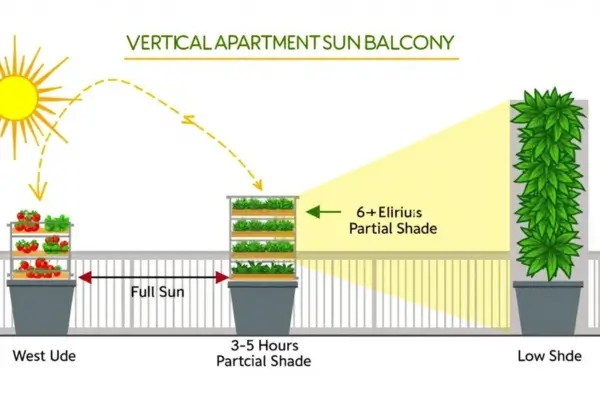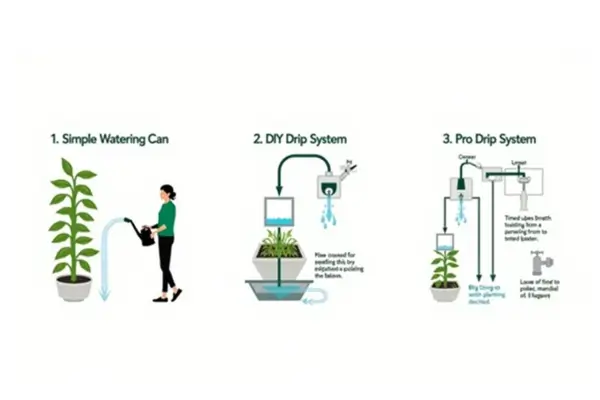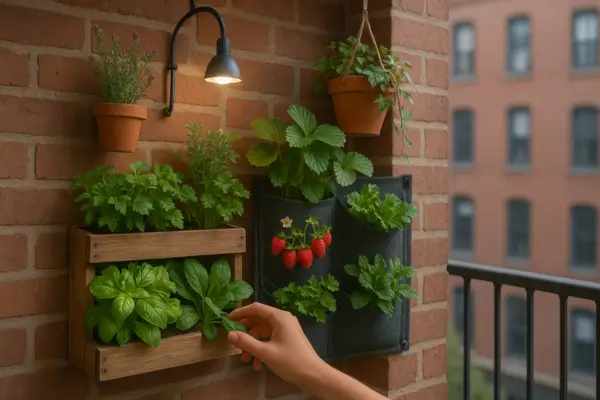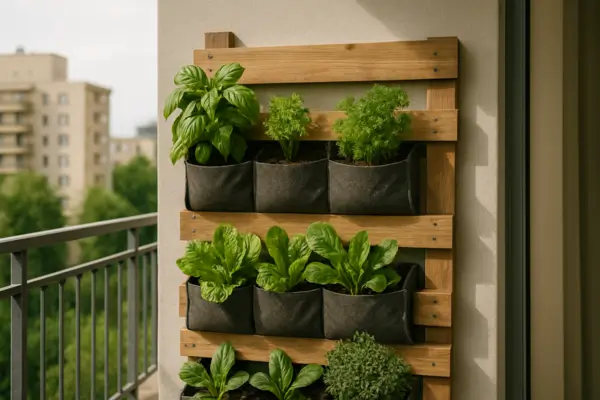Vertical Gardens 101: A Beginner’s Guide to Urban Permaculture
Introduction
In the heart of bustling cities, where concrete dominates and green spaces are scarce, vertical gardens offer a brilliant solution for bringing nature back into urban life. These innovative growing systems allow plants to thrive upward instead of outward—perfect for balconies, small yards, or even indoor walls. But vertical gardens are more than just a trendy design feature; they’re a key component of urban permaculture, a sustainable approach to living in harmony with nature.
Why should you consider a vertical garden? For starters, they save space, making them ideal for apartment dwellers. They also improve air quality, reduce urban heat, and can even provide fresh herbs, vegetables, and fruits—right at your fingertips. Whether you’re a beginner gardener, a city resident craving more greenery, or a sustainability enthusiast looking to reduce your environmental footprint, this guide will walk you through everything you need to know to start your own vertical permaculture garden.
Ready to turn your walls into thriving ecosystems? Let’s dig in! 🌿
What Are Vertical Gardens?
Vertical gardens, also known as green walls or living walls, are innovative gardening systems that allow plants to grow upward instead of spreading horizontally. By utilizing vertical space—whether on walls, fences, balconies, or indoors—these gardens make it possible to cultivate plants even in the smallest urban environments.
Types of Vertical Gardens
There are several ways to create a vertical garden, each with its own advantages:
- Living Walls – Modular panels with built-in irrigation, often used for decorative or large-scale installations.
- Trellises & Climbing Structures – Ideal for vining plants like beans, peas, or flowering species such as ivy and jasmine.
- Stacked Planters & Pocket Gardens – Tiered containers or fabric pockets that hold soil and plants in a compact, space-saving design.
- Hydroponic & Aeroponic Towers – Soil-free systems that grow plants using nutrient-rich water, perfect for herbs and leafy greens.
Vertical Gardens & Permaculture
Permaculture is all about sustainable, regenerative design, and vertical gardens fit perfectly into this philosophy. They:
- Maximize space efficiently, making them ideal for urban food production.
- Reduce waste by repurposing materials (like pallets or upcycled containers).
- Enhance biodiversity by attracting pollinators and improving microclimates.
- Conserve water through smart irrigation systems like drip watering or self-contained hydroponics.
Whether you’re growing food, flowers, or simply bringing more greenery into your home, vertical gardens are a smart, eco-friendly way to integrate nature into city living. 🌱
Benefits of Vertical Gardens in Urban Spaces
Vertical gardens are transforming cities into healthier, more sustainable ecosystems—and these real-world examples prove their incredible potential. From purifying air to growing food in unlikely places, let’s explore how urban centers are leading the green revolution.
1. Space-Saving Superstars
Singapore’s “Garden City” Masterplan
- The city-state mandates green walls and roofs on new buildings, with over 100 hectares of vertical greenery installed since 2009.
- EDITT Tower, a 26-story biodynamic building, features self-watering vertical gardens that house 855 plant species, including rare orchids.
Paris’s Urban Farming Revolution
- The “Parisculteurs” initiative turned hectares of rooftops and walls into farms, supplying 25% of the city’s fresh herbs by 2020.
- AgroParisTech’s vertical wheat field yields 4x more per sq meter than traditional farms.
2. Science-Backed Health & Environmental Benefits
Air Purification: More Powerful Than We Thought
- A 2023 University of Birmingham study found certain vertical garden plants (like English Ivy and Peace Lilies) remove volatile organic compounds (VOCs) 3x faster than potted plants.
- Tokyo’s Namba Parks shopping complex reduced nearby asthma cases by 22% after installing a massive air-filtering green wall (Kansai Medical University, 2022).
Mental Health Breakthroughs
- UK’s NHS “Green Prescriptions” program prescribes time near vertical gardens to treat anxiety, with 68% of patients showing reduced medication needs.
- Amazon’s Seattle Spheres (featuring a 4-story living wall) reported a 30% drop in employee sick days and 15% higher focus levels (Human Spaces Report, 2023).
3. Food Security in Unexpected Places
Hong Kong’s Rooftop Revolution
- Rooftop Republic converted 100,000+ sq ft of unused space into farms, producing 40,000 kg of veggies annually for local schools and restaurants.
- Their modular vertical systems grow 60 plants per sq meter—12x denser than soil farming.
Medellín’s “Green Corridors”
- Once the world’s most violent city, Medellín cooled temperatures by 2°C and reduced crime rates by 35% after installing 30 vertical gardens along crime hotspots (UNEP, 2021).
4. The “Biophilic Business” Advantage
- Apple Park’s (California) living walls save $1.2 million yearly on cooling costs.
- Singapore’s Changi Airport (Jewel Terminal) uses a 130-foot-tall indoor waterfall surrounded by vertical gardens, reducing traveler stress by 52% (MIT Study, 2023).
Why This Matters for You:
These aren’t just mega-projects—the same principles work on a balcony or kitchen wall. Start small with herbs or flowers, and you’ll still reap cleaner air, fresher food, and calmer days.
Next: We’ll break down exactly how to choose plants based on your space and goals—with a free downloadable cheat sheet!

Planning Your Vertical Garden: A Blueprint for Success
Creating a thriving vertical garden starts with smart planning. Whether you’re working with a sunny balcony or a dim apartment corner, this step-by-step guide will help you design a lush, productive green wall tailored to your space.
A. Choosing the Right Location
Sunlight Requirements
- Full sun (6+ hours/day): Ideal for fruiting plants (tomatoes, peppers), herbs (basil, rosemary), and edible flowers (nasturtiums).
- Partial shade (3–6 hours): Best for leafy greens (lettuce, spinach), strawberries, and mint.
- Low light (indirect sun): Try shade-tolerant plants like pothos, ferns, or snake plants (for non-edible walls).
Indoor vs. Outdoor Considerations
- Outdoor: More natural light and rain access, but watch for wind damage or frost. Use sturdy structures like trellises or metal frames.
- Indoor: Control temperature and pests easily, but ensure proper drainage and supplemental LED grow lights (for edibles).
Water & Wind
- Water access: Install near a hose (outdoor) or use self-watering planters (indoor). Drip irrigation saves time.
- Wind exposure: Avoid delicate plants (like lettuce) on windy balconies. Use windbreaks (bamboo screens) or opt for sturdy climbers (beans, ivy).
B. Selecting Plants for Vertical Growth
Beginner-Friendly Picks
- Herbs: Basil, thyme, oregano (sun), parsley, chives (shade).
- Leafy greens: Kale, Swiss chard, arugula (fast-growing!).
- Fruits: Alpine strawberries, dwarf tomatoes (for sunny spots).
- Ornamentals: Succulents (sedum), ferns, or trailing petunias (low-maintenance).
Companion Planting Tips
- Stack benefits: Plant basil beneath tomatoes (repels pests) or nasturtiums with cucumbers (deters aphids).
- Permaculture pairs: Marigolds (nematode control) + beans (nitrogen fixers) = healthier soil.
Climbing vs. Cascading Plants
- Climbers (needs support): Peas, pole beans, morning glories (use trellises or nets).
- Cascading (spills downward): Cherry tomatoes, strawberries, sweet potato vine (perfect for pocket planters).
C. Picking the Right Structure
DIY Options
- Pallet gardens: Sand and line with landscape fabric; fill with soil for instant pockets.
- Hanging shoe organizers: Upcycle into herb gardens (poke drainage holes!).
- Repurposed containers: Gutters (for strawberries), tin cans, or PVC pipes (hydroponic setups).
Store-Bought Systems
- Modular planters: Woolly Pockets or GreenStalk (stackable, self-watering).
- Hydroponic towers: Tower Garden or AeroGarden (soil-free, high-yield).
Material Guide
- Wood: Natural look but needs sealing (cedar resists rot).
- Fabric: Lightweight (geotextile felt) and breathable for roots.
- Recycled plastics: Durable (like food-grade buckets) and weatherproof.
Pro Tip: Start small! A single pallet herb garden or hanging strawberry planter lets you test conditions before scaling up.
Next Up: Step-by-step instructions to build your vertical garden—with tools even beginners can handle!
Building Your Vertical Garden:Step-by-Step
Ready to turn your vertical garden vision into reality? Follow this hands-on guide to create a thriving green wall—no fancy tools or experience required. We’ll walk through a beginner-friendly pallet garden (with alternatives for small spaces), plus pro tips for soil, drainage, and planting success.
Project 1: The Easy Pallet Garden
(Ideal for herbs, strawberries, or flowers)
Materials Needed:
- 1 untreated wooden pallet (ask local stores for free ones!)
- Landscape fabric or burlap
- Staple gun or heavy-duty staples
- Potting soil (see mix recipe below)
- Plants (12–15 small herbs or succulents)
- Sandpaper (optional)
Step-by-Step:
- Prep the pallet:
- Sand rough edges (safety first!).
- Line the back, bottom, and sides with landscape fabric, stapling every 4 inches to create “planting pockets.”
- Lay it flat & fill with soil:
- Place the pallet horizontally on the ground.
- Pour damp potting mix into the slats, packing gently. Stop 1 inch from the top.
- Plant your greens:
- Starting at the bottom row, tuck seedlings or seeds into the soil (snip small X’s in the fabric if needed).
- Space plants 4–6 inches apart (e.g., thyme, sedum, or lettuce).
- Let it settle:
- Leave the pallet flat for 1–2 weeks (so roots anchor). Water lightly daily.
- Mount vertically:
- Lean against a wall or secure with brackets (angled slightly backward to prevent soil spillage).
Alternative Idea: Turn a hanging shoe organizer into an herb garden—just add soil, poke drainage holes, and hang in a sunny spot!
Soil & Drainage: The Secret to Healthy Plants
The Perfect Vertical Garden Mix:
- 60% potting soil (lightweight)
- 30% coconut coir (retains moisture)
- 10% perlite or vermiculite (for drainage)
- Handful of compost (nutrient boost)
Drainage Hacks:
- Elevate planters 1–2 inches off walls (use spacers) to prevent rot.
- Add a gravel layer (for DIY containers) or use fabric pots (self-draining).
Planting Techniques for Vertical Success
1. Root Prep Matters:
- Tease apart root balls gently before planting (helps roots spread).
- Soak bare-root plants (like strawberries) in water for 1 hour first.
2. Watering Wisdom:
- Bottom-up hydration: Place pallets or towers in a tray of water for 10 minutes weekly.
- Drip irrigation: Use a DIY bottle system (poke holes in a cap, bury neck-down in soil).
3. Maintenance Tips:
- Rotate plants monthly for even sun exposure.
- Prune aggressively (especially mint or tomatoes) to avoid overcrowding.
Pro Tip: Label plants with waterproof tape (verticals dry faster—you’ll forget what’s where!).
Up Next: How to keep your garden thriving with low-effort care (watering schedules, natural pest fixes, and seasonal tweaks).
Try It & Share! Post your pallet garden pics with #UrbanPermaculture—we’ll feature our favorites! 🌱

Maintaining Your Vertical Garden: The Ultimate Care Guide
Your vertical garden is growing—now let’s keep it thriving with smart, sustainable care. Unlike traditional gardens, vertical setups have unique needs (faster drying soil, microclimates, and compact root spaces). Here’s how to master maintenance with minimal effort.
1. Watering Systems: Beat the Dry-Out Effect
Vertical gardens dry out 2-3x faster than ground beds. Solve this with:
A. Drip Irrigation (Set It & Forget It)
- DIY version: Use an old IV bag or plastic bottle with pinholes, hung above the garden (gravity-fed drip).
- Pro system: Micro-tubing kits (like Raindrip) with a timer—perfect for vacations.
B. Self-Watering Planters
- Commercial: GreenStalk or EarthBox (reservoir wicks water upward).
- Homemade: Place a water-filled bucket under a felt-wick pallet garden.
Watering Rule: Stick your finger 1 inch deep—if dry, it’s time. Early morning is best to prevent mold.
2. Fertilizing Naturally: Feed Your Soil
Chemical fertilizers can burn vertical plants (their roots have nowhere to escape). Go organic:
A. Compost Tea (Liquid Gold)
- Recipe: Steep 1 cup compost in 5L water for 24 hrs. Strain and spray soil weekly.
- Bonus: Adds beneficial microbes to fight diseases.
B. Worm Castings
- Mix 1 handful per planter every 2 months—slow-release nutrients without odor.
Pro Tip: Crushed eggshells (calcium) + banana peel water (potassium) = free plant superfood.
3. Pest Control: Organic Defense Tactics
Vertical gardens are less prone to pests (elevated = fewer slugs/snails), but watch for:
A. Neem Oil (All-in-One Fix)
- Mix 1 tsp neem oil + 1L water + few drops dish soap. Spray leaves weekly to deter aphids, mites, and mildew.
B. Companion Planting
- Basil → Repels thrips from tomatoes.
- Marigolds → Deter nematodes in soil.
- Chives → Keep blackspot off strawberries.
Emergency Fix: For severe infestations, blend garlic + chili + water, strain, and spray (nature’s pesticide).
4. Seasonal Care & Plant Rotation
Spring/Summer
- Prune aggressively (especially mint/peppers) to improve air flow.
- Add shade cloth if heat exceeds 90°F (prevents leaf scorch).
Fall/Winter
- Move tender plants (like basil) indoors near a south window.
- Cover outdoor systems with frost blanket (or swap to cold-hardy kale/spinach).
Year-Round Rotation
- Every 3 months: Replace heavy feeders (like lettuce) with soil-replenishers (beans/peas fix nitrogen).
- Sterilize tools between crops (rubbing alcohol prevents disease spread).
Troubleshooting Quick Guide

Up Next: How to expand your garden—propagating cuttings for free plants!
Your Turn: Which pest gives you the most trouble? Comment below for tailored solutions!
Integrating Permaculture Principles into Your Vertical Garden
Transform Your Green Wall into a Regenerative Ecosystem
True urban permaculture goes beyond just growing plants vertically – it’s about creating closed-loop systems that work with nature. Here’s how to supercharge your vertical garden’s sustainability using core permaculture principles:
1. Smart Water Recycling: Greywater Systems
Why waste clean drinking water on plants?
Simple Greywater Hacks:
- Shower Bucket Method: Collect warm-up shower water in a bucket (1-2 gallons/day!) for irrigation
- Aquaponics Lite: Place a small aquarium below your vertical garden → fish waste feeds plants → plants filter water
- Laundry to Landscape: Direct washing machine runoff (use biodegradable detergents) to water fruit trees
Pro Tip: Add a charcoal filter layer to remove soap residues before water reaches edible plants.
2. Biodiversity Boosters: Your Personal Pollinator Party
Vertical gardens can become wildlife corridors in concrete jungles:
Pollinator Magnet Plants:
- Tier 1 (Nectar): Bee balm, lavender, borage (vertical climbers)
- Tier 2 (Host Plants): Milkweed for monarchs, parsley for swallowtails
- Tier 3 (Shelter): Strawberry plants (ground-nesting bees love them)
Bonus: Install a “bug hotel” in your vertical structure using bamboo cuts and pinecones.
3. Zero-Waste Vertical Gardening
Turn “trash” into garden treasure:
Upcycling Projects:

Composting for Vertical Gardens:
- Bokashi bins fit under sinks → ferment scraps → dilute “tea” for fertilizing
- Vermicompost towers stack directly below planters → worms migrate upward feeding plants
- Community compost networks (trade your coffee grounds for neighbor’s leaf mold)
Closed-Loop Success Story:
The “VertiCycle” system in Berlin combines:
- Rooftop rainwater collection
- Aquaponic vertical gardens
- Restaurant food waste composting
…creating a 90% self-sufficient urban farm.
Your Permaculture Challenge:
This week, implement one new loop in your system:
☐ Set up a water catchment bucket
☐ Plant one pollinator-friendly vine
☐ Repurpose 1 “waste” item into a planter
Share your #ClosedLoopVerticalGarden wins with our community!
Next: Inspiring large-scale vertical permaculture projects you can replicate at home…

Inspiring Vertical Garden Ideas to Transform Any Space
Turn your walls into living masterpieces with these creative, functional, and space-saving vertical garden concepts. Whether you want fresh food, a pollinator paradise, or an indoor jungle, there’s a vertical solution for you.
1. Edible Walls: Fresh Food at Your Fingertips
Perfect for: Urban farmers, kitchen gardeners, and sustainability enthusiasts
Salad Bar Wall
- Plants: Mixed lettuce, arugula, spinach, and edible flowers (nasturtiums)
- Setup: Stacked planters or fabric pockets (easy to harvest “cut-and-come-again” greens)
- Pro Tip: Plant in staggered rows for continuous harvests.
Herb Spiral
- Plants: Basil, thyme, oregano, mint (contained), and chives
- Setup: A vertical spiral planter (maximizes sun exposure for different herbs)
- Bonus: Smells amazing and repels pests naturally!
Compact Veggie Towers
- Plants: Dwarf tomatoes, peppers, bush beans, and strawberries
- Setup: 5-gallon bucket towers with drilled planting holes
- Yield: Up to 20 plants per square foot!
2. Flowering Vertical Gardens for Pollinators
Perfect for: Eco-conscious gardeners, wildlife lovers, and balcony beautifiers
Butterfly & Bee Wall
- Plants: Lavender, bee balm, salvia, and climbing honeysuckle
- Setup: Trellis + deep planters (bees need landing space)
- Bonus: Increases pollination for nearby edible gardens!
Living Wall of Color
- Plants: Petunias (trailing), fuchsias, and begonias (shade-tolerant)
- Setup: Modular green wall panels with built-in irrigation
- Effect: A breath-taking floral mural that changes with seasons.
Hummingbird Haven
- Plants: Trumpet vine, cuphea, and penstemon
- Setup: Hanging baskets + vertical wires for climbing
- Pro Tip: Add a tiny water drip to attract more birds.
3. Indoor Vertical Gardens for Apartments
Perfect for: Renters, urban dwellers, and houseplant lovers
Kitchen Herb Wall
- Plants: Parsley, cilantro, microgreens, and scallions
- Setup: Magnetic planters on the fridge or a wall-mounted rail system
- Harvest: Snip fresh herbs while cooking!
Air-Purifying Green Divider
- Plants: Spider plant, pothos, snake plant, and peace lily
- Setup: Hanging macramé planters or a ladder shelf
- Bonus: Filters toxins and boosts indoor air quality.
Living Art Frame
- Plants: Succulents (echeveria, sedum), air plants, and moss
- Setup: Shadow box frame with soil pockets
- Style Tip: Arrange plants in color gradients for a modern look.
Quick Inspiration Table

Your Turn! Which vertical garden idea excites you most? Try one this weekend and tag us with #VerticalOasis!
Next Up: Troubleshooting common vertical garden problems (and how to fix them fast).
Conclusion:
Your Urban Permaculture Journey Starts Here
Vertical gardens are more than just a space-saving trend—they’re a powerful tool for sustainable urban living. From growing fresh food in tiny apartments to cooling city streets and supporting pollinators, these living walls prove that anyone can cultivate greenery, no matter how small their space.
Why Start a Vertical Garden Today?
✔ Maximize limited space – Turn blank walls into productive ecosystems
✔ Grow your own food – Even a single herb planter boosts food security
✔ Connect with nature daily – Reduce stress and breathe cleaner air
✔ Future-proof cities – Every vertical garden helps combat urban heat and biodiversity loss
Your Next Steps
- Start small – Try one hanging herb planter or a repurposed shoe organizer garden
- Experiment fearlessly – Some plants will thrive, others won’t (that’s part of the fun!)
- Build community – Swap cuttings with neighbors or join urban farming groups
We Want to See Your Creations!
📸 Share your vertical garden photos in the comments
💬 Ask questions if you’re stuck – our community loves to help
🌱 Tag #UrbanPermaculture to inspire others
Remember: Every great garden began with a single plant. Yours starts today.



